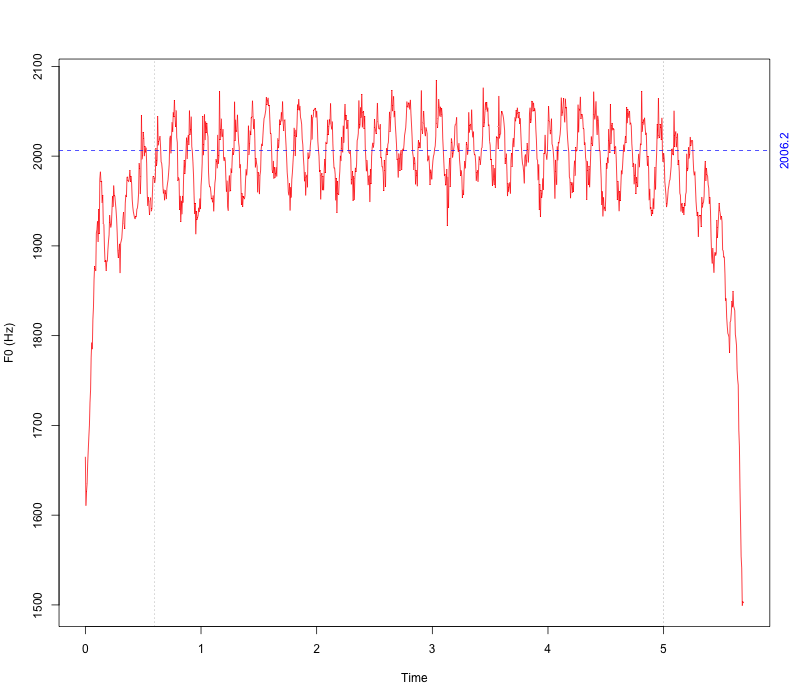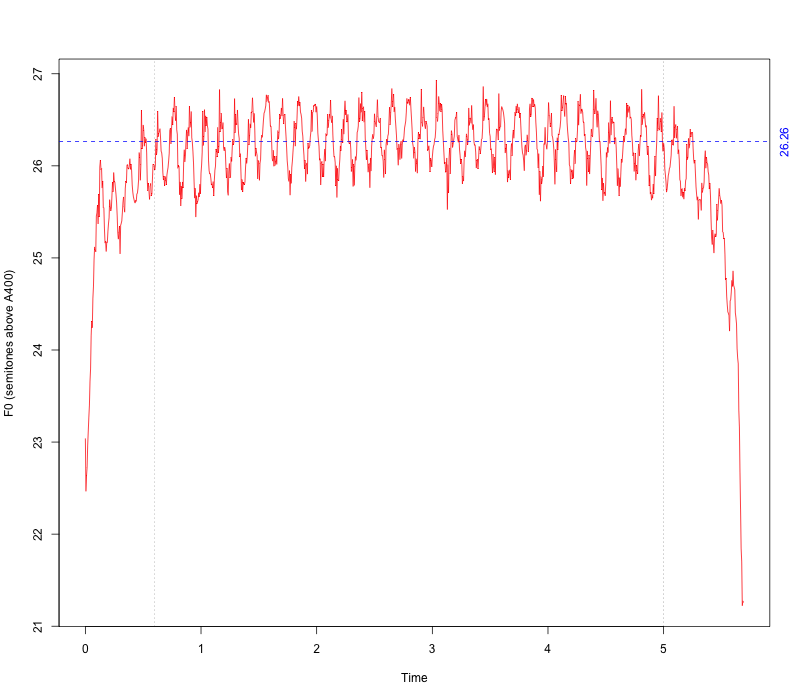Record-high operatic pitch?
« previous post | next post »
Zachary Woolfe, "Hyper-High Notes", NYT 11/10/2017:
I wrote this week about the highest note in the history of the Metropolitan Opera, an A above high C currently being sung by Audrey Luna in Thomas Adès’s “The Exterminating Angel.” In my brief rundown of high-note history, I referred to the French soprano Mado Robin “shrilling” up to a high B flat; my infelicitous phrasing got called out by some Mado fans, one of whom was kind enough to send along a couple of her highlights. Recorded live, this is, my reader tells me, a French version of one of the big Miliza Korjus showpieces from the 1938 MGM musical “The Great Waltz.” Its climax takes her up to what I believe (correct me if I’m wrong) is quite a lovely sustained B flat, half a step above Ms. Luna’s achievement.
If the cited youtube clip has not been juiced, Mr. Woolfe is indeed wrong — the note in question is a (quarter tone above) a sustained B6, around 2006 Hz.
Here's audio for the note in question (at around 4:00 into the clip):
And here's a plot of the fundamental frequency as a function of time, first in cycles per second:
And then in semitones relative to A440:
The singer's (7.3 Hz) vibrato is of course very prominent, so in both cases I've taken the mean value of what seems to be the stable middle region of the note, between the vertical dotted lines.
26.26 semitones (12*log2(2006.2/440)) is two octaves, two semitones, and a quarter tone — the two octaves take us from A4 = 440 Hz to A6 = 1760 Hz; the two semitones take us to B6 = 1975.5; and the extra quarter tone takes use to the observed mean value.
Here's the video clip:
https://www.youtube.com/watch?v=g8ImO971SLc
I've been told that it was not uncommon, in the mid to late 20th century, to speed up recordings by a few percent, to increase the perceived vigor or intensity of the performance. And a five or six percent speed-up would give an extra semitone. I haven't checked the score of this opera to see what the note in question should nominally be, nor have I checked other pitches in the youtube version to see whether the whole recording plays at concert pitch or above it.


bratschegirl said,
November 11, 2017 @ 3:38 pm
This was almost certainly an ad lib interpolation, so the note in question wouldn't be in the score, but the score would reveal in which key the aria was originally composed, and you could then check the recording against that concert pitch. Of course, it's not at all unusual for opera arias to be sung and recorded in transposition, either up or down (though more often down), so despite whatever the original key is, this recording might have been of a transposed version, so if this recording is pitched in a higher key than the original score, that's not in itself evidence that the higher key is due to speeding up the recording.
The more standard musical term for what you called "tremolo" in this post is "vibrato." Tremolo usually refers to a rapid repetition of the same pitch; vibrato refers to subtle changes in the pitch itself used intentionally as an expressive device.
[(myl) Sorry, I should have remembered that tremolo is amplitude oscillation and vibrato is pitch oscillation… Fixed now.]
AntC said,
November 11, 2017 @ 4:41 pm
Ouch! Listening to the full recording is really quite painful.
It might be opera, but it ain't music.
cameron said,
November 11, 2017 @ 5:02 pm
Leo Fender is probably to blame for much of the confusion between the terms tremolo and vibrato. The device to manipulate the bridge on the Stratocaster guitar (and later models) was marketed by Fender as the "tremolo bar". And the feature of various Fender amplifier models that implemented amplitude oscillation was referred to as "vibrato". Guitarists still misuse the terms to this day.
Andrew Usher said,
November 11, 2017 @ 6:54 pm
AntC:
Indeed, opera is like that. It no doubt started as genuine musical entertainment, but once it became a snob thing it became more a feat of endurance that anything resembling fun (not the only thing that's true of …).
In fact, it is not possible to sing well at high pitches, because the formants become inaudible (if she's trying to sing any words at all, which I can't even make out); and, without amplification, producing sufficient power at those frequencies sounds awful. Producing such a pitch at all is no real feat, I – a male with an undistinguished voice – can reach 1500 cycles. And Google will easily show examples much higher than that.
This is why female singers generally sound worse than men at the same skill level, etc. – although, the average female singer one hears does, I think, have a higher vocal skill level than the average male singer. But the best singing voices are necessarily near the low end.
k_over_hbarc at yahoo.com
Jerry Friedman said,
November 11, 2017 @ 10:37 pm
cameron: The confusion between "vibrato" and "tremolo" is much older than Leo Fender. The OED cites:
"1884 H. C. Deacon in Grove Dict. Music IV. 166/2 The instrumental tremolo is more nearly allied to the vocal vibrato. Indeed, what is called ‘vibrato’ on bowed instruments is what would be ‘tremolo’ in vocal music."
Dagwood said,
November 12, 2017 @ 2:09 am
With all due respect, maestro, putting in much effort without first ascertaining the "A440 orientation" of the source recordings is a bit of a fool's errand.
Rubrick said,
November 12, 2017 @ 6:17 am
@Andrew Usher: This is why female singers generally sound worse than men at the same skill level … the best singing voices are necessarily near the low end.
It is fortunate indeed both that singing quality has a one-dimensional, universally-agreed-upon metric, and that we have such an (unsnobbish, of course) expert to pontificate about it for our edification.
Come to think of it, singing is much like sarcasm in that regard….
Coby Lubliner said,
November 12, 2017 @ 9:01 am
Does anyone know which operetta it is? Aimer, boire et chanter sounds like a sort of translation of Wein, Weib und Gesang, but this is the title of a free-standing waltz, not an operetta. I see no title in the Strauss operetta list that would seem to match it.
Coby Lubliner said,
November 12, 2017 @ 9:04 am
Sorry, bad link. (What ever happened to previews?) Here it is again: list
Jerry Friedman said,
November 12, 2017 @ 11:21 am
Dagwood: The effort of determining what frequency Mado Robin sang wasn't wasted if it can be compared to the frequency Audrey Luna sings, and the frequency is the only basis for comparing how high they sing. I agree with you, though, that determining what notes people sing—A or B-flat or B or a quarter-tone off something—requires knowing what pitch the orchestra is tuned to.
Jerry Friedman said,
November 12, 2017 @ 12:05 pm
I should add that Prof. Liberman says at the end of his post, "…nor have I checked other pitches in the youtube version to see whether the whole recording plays at concert pitch or above it." However, it appears that opera sometimes uses pitches lower than A=440 Hz, according to this NYT article from 1989.
Coby Lubliner: The English title of the aria is "There'll Come a Time", and according to this Youtube video, the German title is "O schöner Mai!" Then according to this Wikipedia article, the music is from Prinz Methusalem
D.O. said,
November 12, 2017 @ 1:46 pm
I don't know in what medium that recording was made, but one of the great Russian romance singers complained that the recordings at the peak of her career were made at 78 or 45 rpm and made faster to include longer times. That made her pitch higher and, in romance singing, the low female voice is considered more beautiful.
D.O. said,
November 12, 2017 @ 2:01 pm
I am not what AntC and Andrew Usher are complaining about. Yes, this performance has all the marks of its time, but denouncing it for that is like complaining that men wore britches and women crinolines. The times are changing and we are changing with them. The area itself is banal in its melodic part (I do not know the real terminology, sorry for that) and pretty absurd in coloratura, but singing itself doesn't deserve the scorn.
Andrew Usher said,
November 12, 2017 @ 4:35 pm
D.O.:
I assume you meant 'aria' not 'area' and meant to put the definite article before 'singing', otherwise it makes little sense.
If you are talking about merely historical value, you are of course right. But if we want to discuss the quality _as music_ (or art, or whatever), that is timeless and "it's of its time" is really no defence. Your comparison of fashion is off because people don't usually assign intrinsic value to fashions – but when they do, that is treated likewise as timeless.
Also, my opinion that lower voices are better, all things equal, can only be a matter of taste, yes. But there are several lines of evidence that lead me to it (including listening to myself at different pitches) and a spectrogram is unequivocal that the formants are more distinct, the lower the fundamental – and when that is so, one has more freedom to manipulate one's voice otherwise and retain intelligibility; more signal to noise you might say.
AntC said,
November 12, 2017 @ 5:47 pm
@D.O. singing itself doesn't deserve the scorn.
I was complaining that my ears hurt. Same as if someone blew a whistle at length. I was not passing judgment on Mado's performance or repertoire.
It was not a case of "scorn" or cultural condemnation. Nor a remark specifically to do with changing times: I have a similar reaction to loud pop music. (I must admit I had only the evening before thrilled to a stunning performance of Gershwin's Piano Concerto in F, preceded by John Adams' Short Ride in a Fast Machine'.)
D.O. said,
November 12, 2017 @ 7:15 pm
Sorry for misspellings. Timelessness of art does not mean we cannot adjust to historical conventions. Otherwise we would not be able to enjoy the art more than 30 years old. AntC, I am sorry that your ears hurt. There is plenty of great music around and no need to listen to whatever hurts you. I personally do not listen to rap and is bored stiff by most varieties of musical traditions from around the world . Still, I wouldn't claim that it's anything but my personal (lack of) taste.
AntC said,
November 12, 2017 @ 9:42 pm
@D.O. the art more than 30 years old.
Au contraire, there's been no decent music written since the '50's. And I mean the 1750's/death of Bach ;-) I'll make an exception for Gershwin, and Shostakovich and Prokofiev and Stravinsky, Bartok, Poulenc and Britten and Elgar and Charlie Parker, Miles Davis, Thelonius Monk, Dave Brubeck/Paul Desmond, … Oh. I won't make an exception for C19th high oper(ett)a.
Keith said,
November 13, 2017 @ 3:55 am
I've long maintained that Opera is just singing the vowels with only a very occasional consonant here and there. I enjoy a lot of it, though.
I find more interesting the written caption on the image shown on this page. The lower left-hand corner shows the French "Aimer, Boire et Chanter", meaning "Love, drink and sing", whereas in the top right-hand side we see the more recently added "Aimer boire et chanter", meaning "Love to drink and to sing". It reminds me of two things: the book "Eats, Shoots & Leaves" by Lynne Truss, and a line from "The Bartender and the Thief" by the Sterophonics.